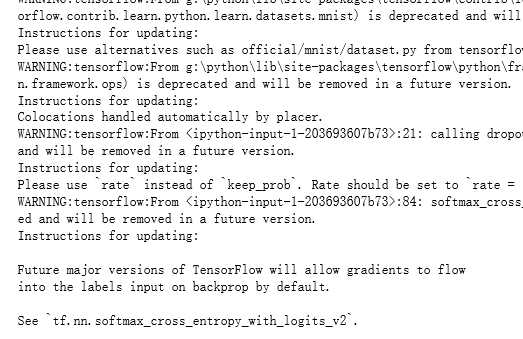吴裕雄 python 神经网络——TensorFlow 使用卷积神经网络训练和预测MNIST手写数据集
Posted tszr
tags:
篇首语:本文由小常识网(cha138.com)小编为大家整理,主要介绍了吴裕雄 python 神经网络——TensorFlow 使用卷积神经网络训练和预测MNIST手写数据集相关的知识,希望对你有一定的参考价值。
import tensorflow as tf import numpy as np from tensorflow.examples.tutorials.mnist import input_data #设置输入参数 batch_size = 128 test_size = 256 # 初始化权值与定义网络结构,建构一个3个卷积层和3个池化层,一个全连接层和一个输出层的卷积神经网络 # 首先定义初始化权重函数 def init_weights(shape): return tf.Variable(tf.random_normal(shape, stddev=0.01)) # 第一组卷积层以及池化层,最后 droupout是为了防止过拟合,在模型训练的时候丢掉一些神经元 # padding表示对边界的处理,SAME表示卷积的输入和输出保持同样尺寸 def model(X, w, w2, w3, w4, w_o, p_keep_conv, p_keep_hidden): l1a = tf.nn.relu(tf.nn.conv2d(X, w,strides=[1, 1, 1, 1], padding=‘SAME‘)) # l1 shape=(?, 14, 14, 32) l1 = tf.nn.max_pool(l1a, ksize=[1, 2, 2, 1],strides=[1, 2, 2, 1], padding=‘SAME‘) l1 = tf.nn.dropout(l1, p_keep_conv) # 第二组卷积层及池化层,最后dropout一些神经元 # l2a shape=(?, 14, 14, 64) l2a = tf.nn.relu(tf.nn.conv2d(l1, w2, strides=[1, 1, 1, 1], padding=‘SAME‘)) # l2 shape=(?, 7, 7, 64) l2 = tf.nn.max_pool(l2a, ksize=[1, 2, 2, 1],strides=[1, 2, 2, 1], padding=‘SAME‘) l2 = tf.nn.dropout(l2, p_keep_conv) # 第三组卷积神经网络及池化层,同样,最后dropout一些神经元 # l3a shape=(?, 7, 7, 128) l3a = tf.nn.relu(tf.nn.conv2d(l2, w3,strides=[1, 1, 1, 1], padding=‘SAME‘)) # l3 shape=(?, 4, 4, 128) l3 = tf.nn.max_pool(l3a, ksize=[1, 2, 2, 1],strides=[1, 2, 2, 1], padding=‘SAME‘) # reshape to (?, 2048) l3 = tf.reshape(l3, [-1, w4.get_shape().as_list()[0]]) l3 = tf.nn.dropout(l3, p_keep_conv) # 全连接层 l4 = tf.nn.relu(tf.matmul(l3, w4)) l4 = tf.nn.dropout(l4, p_keep_hidden) # 输出层 pyx = tf.matmul(l4, w_o) return pyx # 导入数据 mnist = input_data.read_data_sets("E:\\\\MNIST_data\\\\", one_hot=True) # 定义四个变量,分别为输入训练图像矩阵及其标签,输入测试图像矩阵及其标签 trX, trY, teX, teY = mnist.train.images, mnist.train.labels, mnist.test.images, mnist.test.labels # -1表示布考虑输入图片的数量,28*28为图片的像素数,1是通道(channel)的数量, # 因MNIST图片为黑白,彩色图片通道是3 # 28x28x1 trX = trX.reshape(-1, 28, 28, 1) # 28x28x1 teX = teX.reshape(-1, 28, 28, 1) X = tf.placeholder("float", [None, 28, 28, 1]) # 10为识别图片的类别从0到9,共10个取值 Y = tf.placeholder("float", [None, 10]) # 定义模型函数 # 神经网络模型的构建函数,传入以下参数 # X:输入数据 # w: 每一层权重 # 大小为3*3,输入的维度为1 ,输出维度为32 w = init_weights([3, 3, 1, 32]) # 大小为3*3,输入维度为32,输出维度为64 w2 = init_weights([3, 3, 32, 64]) # 大小为3*3,输入维度为64,输出维度为128 w3 = init_weights([3, 3, 64, 128]) # 全连接层,输入维度为128*4*4,也就是上一层的输出,输出维度为625 w4 = init_weights([128 * 4 * 4, 625]) # 输出层,输入的维度为625, 输出110维,代表10类(labels) w_o = init_weights([625, 10]) # p_keep_conv,p_keep_hidden:dropout 保留神经元比例 # 定义dropout的占位符keep_conv,表示一层中有多少比例的神经元被保留,生成网络模型,得到预测数据 # 在训练的时候把设定比例的节点改为0,避免过拟合 p_keep_conv = tf.placeholder("float") p_keep_hidden = tf.placeholder("float") py_x = model(X, w, w2, w3, w4, w_o, p_keep_conv, p_keep_hidden) # 定义损失函数,采用tf.nn.softmax_cross_entropy_with_logists,作为比较预测值和真实值的差距 # 定义训练操作(train_op) 采用RMSProp算法作为优化器, cost = tf.reduce_mean(tf.nn.softmax_cross_entropy_with_logits(logits=py_x, labels=Y)) train_op = tf.train.RMSPropOptimizer(0.001, 0.9).minimize(cost) predict_op = tf.argmax(py_x, 1) #在会话中定义图,开始训练和评估 # Launch the graph in a session with tf.Session() as sess: # you need to initialize all variabels tf.global_variables_initializer().run() for i in range(100): training_batch=zip(range(0,len(trX),batch_size),range(batch_size,len(trX)+1,batch_size)) for start, end in training_batch: sess.run(train_op, feed_dict={X: trX[start:end], Y: trY[start:end],p_keep_conv: 0.8, p_keep_hidden: 0.5}) test_indices = np.arange(len(teX)) # Get A Test Batch np.random.shuffle(test_indices) test_indices = test_indices[0:test_size] #预测的时候设置为1 即对全部样本进行迭代训练 print(i, np.mean(np.argmax(teY[test_indices], axis=1) ==sess.run(predict_op, feed_dict={X: teX[test_indices],p_keep_conv: 1.0,p_keep_hidden: 1.0})))

以上是关于吴裕雄 python 神经网络——TensorFlow 使用卷积神经网络训练和预测MNIST手写数据集的主要内容,如果未能解决你的问题,请参考以下文章
吴裕雄 python 神经网络——TensorFlow 输入文件队列
吴裕雄 python 机器学习——人工神经网络感知机学习算法的应用
吴裕雄 python 神经网络——TensorFlow 队列操作
吴裕雄 python 神经网络——TensorFlow 数据集高层操作